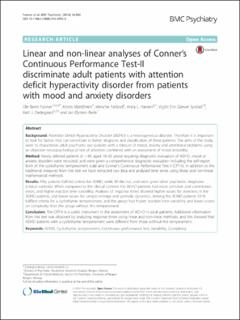| dc.contributor.author | Fasmer, Ole Bernt | |
| dc.contributor.author | Mjeldheim, Kristin | |
| dc.contributor.author | Førland, Wenche | |
| dc.contributor.author | Hansen, Anita Lill | |
| dc.contributor.author | Syrstad, Vigdis Elin Giæver | |
| dc.contributor.author | Ødegaard, Ketil Joachim | |
| dc.contributor.author | Berle, Jan Øystein | |
| dc.date.accessioned | 2020-06-08T11:32:52Z | |
| dc.date.available | 2020-06-08T11:32:52Z | |
| dc.date.created | 2016-09-21T16:02:19Z | |
| dc.date.issued | 2016 | |
| dc.identifier.citation | BMC Psychiatry. 2016, 16:284 . | en_US |
| dc.identifier.issn | 1471-244X | |
| dc.identifier.uri | https://hdl.handle.net/11250/2657206 | |
| dc.description.abstract | Background: Attention Deficit Hyperactivity Disorder (ADHD) is a heterogeneous disorder. Therefore it is important to look for factors that can contribute to better diagnosis and classification of these patients. The aims of the study were to characterize adult psychiatric out-patients with a mixture of mood, anxiety and attentional problems using an objective neuropsychological test of attention combined with an assessment of mood instability. Method: Newly referred patients (n= 99; aged 18–65 years) requiring diagnostic evaluation of ADHD, mood oranxiety disorders were recruited, and were given a comprehensive diagnostic evaluation including the self-reportform of the cyclothymic temperament scale and Conner’s Continuous Performance Test II (CPT-II). In addition to the traditional measures from this test we have extracted raw data and analysed time series using linear and non-linear mathematical methods. Results: Fifty patients fulfilled criteria for ADHD, while 49 did not, and were given other psychiatric diagnoses(clinical controls). When compared to the clinical controls the ADHD patients had more omission and commissionerrors, and higher reaction time variability. Analyses of response times showed higher values for skewness in the ADHD patients, and lower values for sample entropy and symbolic dynamics. Among the ADHD patients 59 %fulfilled criteria for a cyclothymic temperament, and this group had higher reaction time variability and lower scores on complexity than the group without this temperament. Conclusion: The CPT-II is a useful instrument in the assessment of ADHD in adult patients. Additional information from this test was obtained by analyzing response times using linear and non-linear methods, and this showed that ADHD patients with a cyclothymic temperament were different from those without this temperament. | en_US |
| dc.language.iso | eng | en_US |
| dc.publisher | BMC | en_US |
| dc.title | Linear and non-linear analyses of Conner's Continuous Performance Test-II discriminate adult patients with attention deficit hyperactivity disorder from patients with mood and anxiety disorders | en_US |
| dc.type | Peer reviewed | en_US |
| dc.type | Journal article | en_US |
| dc.description.version | publishedVersion | en_US |
| dc.source.pagenumber | 10 | en_US |
| dc.source.volume | 16:284 | en_US |
| dc.source.journal | BMC Psychiatry | en_US |
| dc.identifier.doi | 10.1186/s12888-016-0993-4 | |
| dc.identifier.cristin | 1383889 | |
| dc.description.localcode | © 2016 The Author(s).Open AccessThis article is distributed under the terms of the Creative Commons Attribution 4.0. International License (http://creativecommons.org/licenses/by/4.0/), which permits unrestricted use, distribution, and reproduction in any medium, provided you give appropriate credit to the original author(s) and the source, provide a link to the Creative Commons license, and indicate if changes were made. The Creative Commons Public Domain Dedication waiver(http://creativecommons.org/publicdomain/zero/1.0/) applies to the data made available in this article, unless otherwise stated. | en_US |
| cristin.ispublished | true | |
| cristin.fulltext | original | |
| cristin.qualitycode | 1 | |
